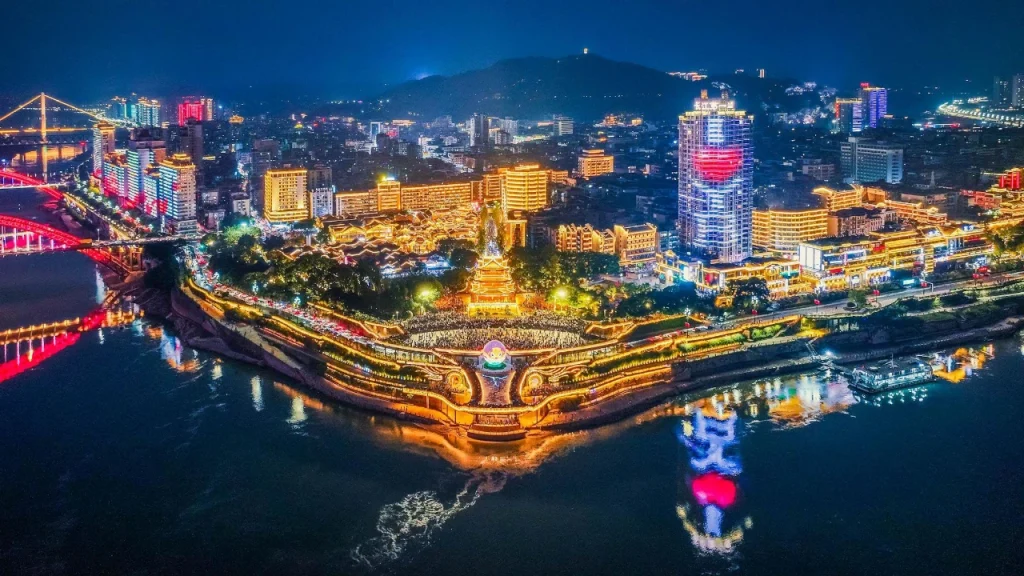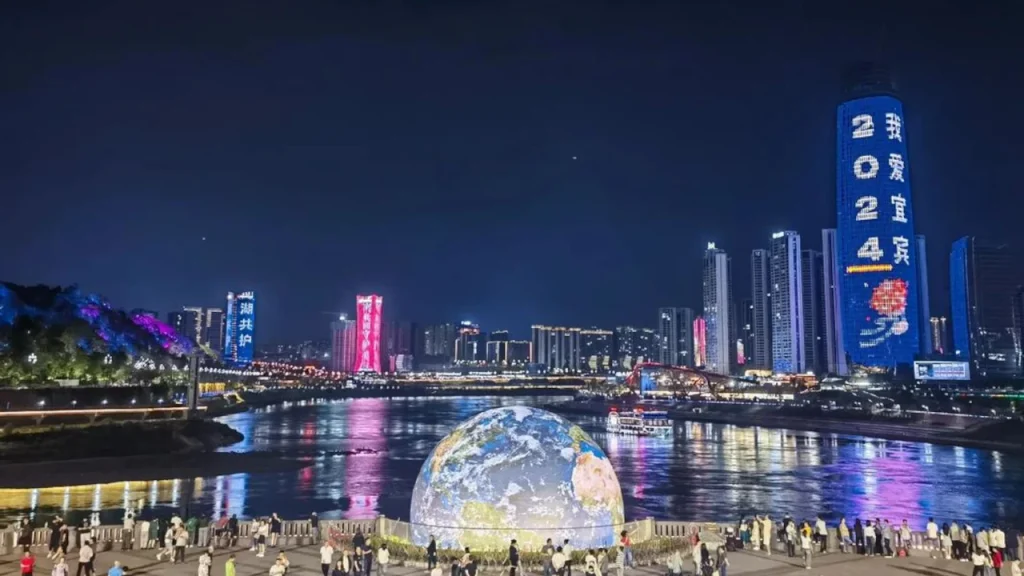I. Yibin: The First City Along the Yangtze River – A Multifaceted Tapestry of History, Spirit and Flavor
Nestled at the junction of Sichuan, Yunnan, and Guizhou provinces, the Jinsha River and Min River converge here to form the majestic Yangtze River, earning Yibin the geographic title of “the First City Along the Yangtze River.” With a 2,200-year history of urban settlement, this ancient city served as the starting point of the Southern Silk Road in antiquity and now shines as China’s Liquor Capital. Strolling through Hejiangmen Square, one witnesses the confluence of three rivers (Jinsha, Min, and Yangtze) surging eastward, while the breeze carries the mellow aroma of Wuliangye (a renowned Chinese liquor). In the laneways, the fragrance of red oil and preserved mustard greens from local “ranmian” (spicy hot dry noodles) eateries weaves a poetic symphony of everyday life.

II. Cultural Landmarks Along the River of Time
Lizhuang Ancient Town: A Beacon of Cultural Resistance
In 1940, a 16-character telegram—”Tongji University relocates to Sichuan; Lizhuang extends its welcome”—transformed this Yangtze-side town into one of China’s four major cultural centers during the Anti-Japanese War (alongside Chongqing, Chengdu, and Kunming). The influx of Tongji University, the Institute of History and Philology (Academia Sinica), and other institutions enabled scholars like Fu Sinian, Li Ji, and Liang Sicheng to pursue academic patriotism amidst black-tile-and-white-wall courtyards. Today, at Site 8 on Yangjie Street—the former Tongji Engineering School campus—visitors can still trace the legacy of “where culture endures, the nation survives.”
Bo People’s Hanging Coffins: Millennium-Old Cliffside Enigmas
On the red cliffs of Danxia landform in Gongxian County’s Matang Valley, over 200 cliff-embedded coffins of the Bo people have silently witnessed time for millennia. These rock-carved tombs, alongside excavated bronze drums and weapons, whisper tales of the ancient Bo civilization. Local legends recount their “fire-walking rituals,” a tradition reimagined today through dance during the Miao Huashan Festival—an annual celebration where heritage leaps into the present.
III. Geographic Tapestry: A Visual Feast from Bamboo Seas to Karst Wonders
Shunan Bamboo Sea: A 45-Square-Kilometer Ocean of Green
Over 100,000 mu (6,667 hectares) of phyllostachys bambusoides blankets 45 square kilometers of hillsides, forming the breathtaking “Bamboo Sea.” Ascending the 1,000-meter-high Guanhai Pavilion, visitors witness an emerald corridor winding like a jade ribbon through the landscape, while the Seven-Color Waterfall plunges 60 meters from cliffs. The canopy walkway, suspended among bamboo tips, offers a cloud-borne stroll, and the full-bamboo banquet—featuring 24 dishes like bamboo fungus stewed chicken and bamboo embryo egg rolls—delights with culinary artistry.
Xingwen Stone Sea: A Karst Kingdom Where Time Dances
Spanning 300 square kilometers, the Xingwen Stone Sea boasts the world’s largest karst cave system at 18 square kilometers. Within Tianquan Cave, the “Shilin Fairy Posture” rock formations and 180-million-year-old dinosaur footprints engage in a silent dialogue with the Bo People’s hanging coffins. Each October, the Miao People’s Caishan Festival revives ancient traditions, with Lusheng (a reed-pipe wind instrument) dances and folk songs echoing through the stone labyrinth.
IV. Yibin on the Plate: A Culinary Realm Alive with Smoke and Flavor
Yibin Ran Mian: The Noodle That Ignites a Legacy
In the morning mist of Ran Mian eateries, alkaline noodles dance in a whirlwind of red oil, mingling with preserved mustard greens, crushed peanuts, and spring onions. This “oil-strip noodle,” originating in the Guangxu era (late 19th century), earned its name for its flammable oil content. A provincial intangible cultural heritage since 2011, connoisseurs insist on “an extra ounce of noodles, half an ounce less oil,” paired with mushroom soup for an authentic morning ritual.
Li Zhuang Bai Rou: The Art of Knife and Spice
At Liufen Restaurant, the third-generation heir wields a 30-cm “bamboo-strip knife” to carve pork belly into translucent rolls thinner than cicada wings. The dipping sauce demands stone-mortar-pounded chili paste blended with 24-spice soy sauce—a dish once hailed by Fu Sinian as “spiritual sustenance during the cultural resistance.” Today, it remains the gastronomic emblem of Li Zhuang’s ancient town.
Nanxi Tofu Gan: A World of Flavor in Every Cube
From the Qing-era “Guo’s Tofu” to today’s geographical indication product, Nanxi tofu undergoes 24 meticulous steps: local soybeans are shaped into cubes, triple-marinated, and twice-roasted to achieve a chewy texture. Artisans still adhere to the “three marinades, three sun-dryings” method, infusing each cube with the essence of over 30 spices.
V. Travel Guide: A Year-Round Immersion in Yibin’s Depths
Spring (March-May):
- Shunan Bamboo Sea: Witness bamboo shoots pierce the soil and join the International Kite Festival amidst emerald waves.
- Li Zhuang Ancient Town: Stroll through rapeseed flower fields and try traditional tie-dye crafting.
Summer (June-August):
- Bowang Mountain: Escape the heat with river tracing and bamboo rafting adventures.
- Wuliangye Scenic Area: Enroll in the “Wine Culture Summer Camp” to learn ancient brewing techniques.
Autumn (September-November):
- Xingwen Stone Sea: Marvel at crimson foliage and celebrate the Miao New Rice Festival with dance and song.
- Nanxi Ancient Street: Savor freshly made tofu gan and release floating lanterns along the Yangtze.
Winter (December-February):
- Qidong Valley: Rejuvenate in hot springs and brave the canyon glass skywalk.
- Cuiping Mountain: Admire millennium-old ginkgo trees and join Zen tea ceremonies.
VI. Urban Character: A Symphony of Tradition and Modernity
In the Wuliangye Industrial Park, traditional brewing workshops coexist with intelligent production lines. At Lingang Economic and Technological Development Zone, CATL’s power battery base collaborates with the university town in an industry-academia-research nexus. This city, honored as a “National Forest City” and “Outstanding Tourist City of China,” is writing a harmonious chapter where traditional industry and ecological civilization coalesce, embracing its identity as “the First City on the Great Yangtze River.”

Epilogue:
The beauty of Yibin lies in the sunrise at Sanjiangkou, in the rustling winds of the Bamboo Sea, in the fragrant red oil of Ran Mian, and even more so in the cobblestone streets of Li Zhuang Ancient Town. This city embodies both the grandeur of mighty rivers and the refined elegance of bamboo groves and tea aroma, all tempered by the calm of 2,200 years of history. Come to Yibin: savor a pot of Wuliangye, enjoy a bowl of Ran Mian, stroll through Li Zhuang, and discover why “the land is so enchanting, adorned by mountains and rivers.”

Leave a Reply